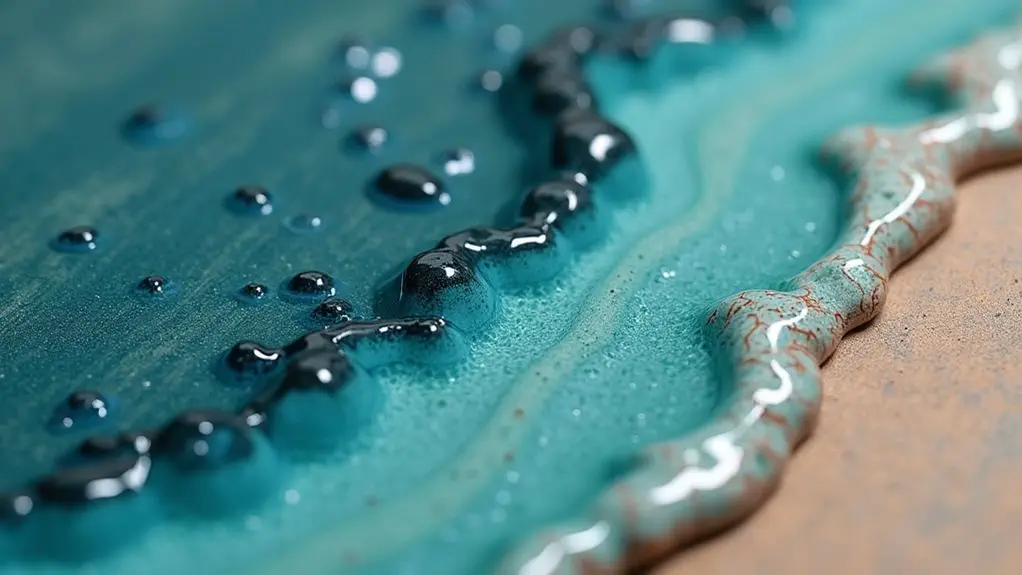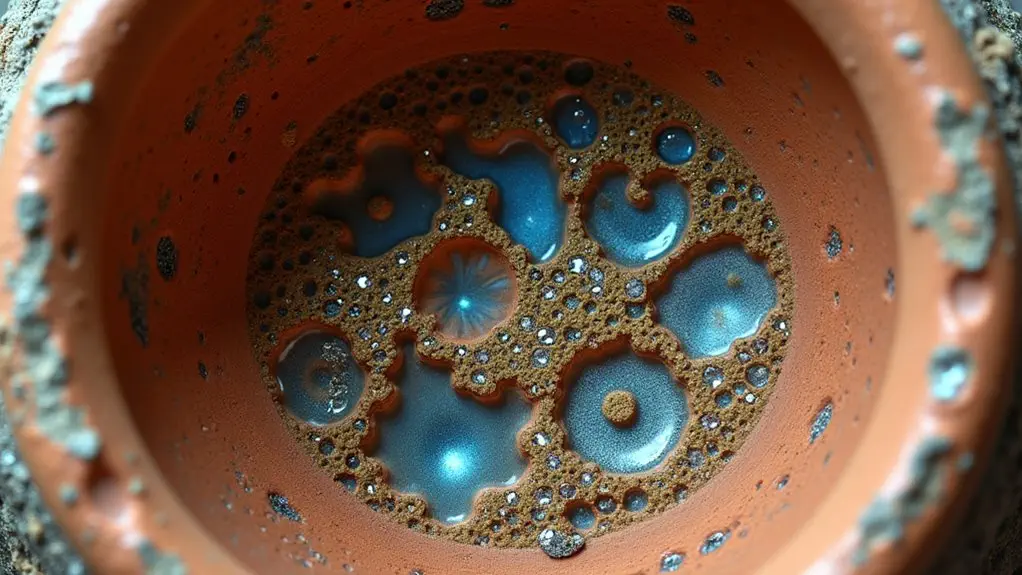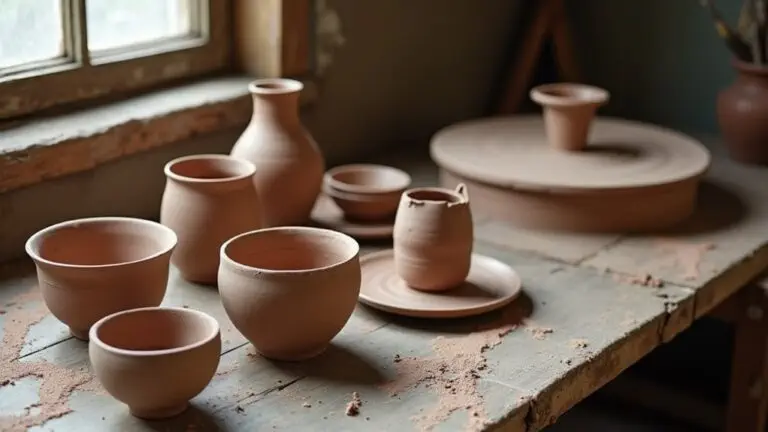Traditional pottery and ceramics merge art and science in fascinating ways you'd never expect. At its core, you'll find clay's unique chemical structure – sheets of silica and alumina that give it that perfect moldable consistency. When you're working with clay, you're actually handling ancient wisdom passed down through generations of potters who mastered firing techniques and glaze chemistry. Each region's distinct clay deposits create unique characteristics in local pottery styles, while modern technology helps us understand these age-old practices better. There's so much more to discover about how simple earth transforms into lasting masterpieces.
Chemical Structure of Clay Materials

Nearly all clay materials used in traditional pottery share a fundamental chemical structure based on sheets of silica and alumina. When you're working with clay, you're actually handling an incredibly sophisticated arrangement of microscopic sheets that fit together like nature's own puzzle pieces.
These sheets are made up of two main components: tetrahedral sheets (imagine tiny pyramids of silica) and octahedral sheets (picture slightly larger structures containing aluminum or magnesium). The natural weathering of feldspar minerals produces these distinctive clay structures.
You'll find it fascinating how these sheets bond together – they're quite picky about it! Within each sheet, they form strong, unbreakable bonds, but between different sheets, they're more like distant cousins who only stick together loosely.
This unique arrangement is what gives clay its amazing plasticity – that's why you can squish and shape it so easily. The real magic happens in the gaps between these sheets, where you'll find OH groups (that's oxygen and hydrogen hanging out together) and various cations floating around.
These elements work together like a well-orchestrated dance, giving different types of clay their distinct personalities and making them perfect for everything from delicate porcelain to sturdy stoneware.
Ancient Firing Techniques Unveiled
The transformative power of fire turns those carefully arranged clay sheets into lasting ceramic treasures. When you look at ancient pottery, you're witnessing the incredible mastery our ancestors had over firing techniques that we're still uncovering today. Wood served as the fuel source for the majority of ancient Greek pottery production.
You'll find that ancient potters weren't limited to just one method – they were quite creative! They'd use open firing, where they'd simply stack pottery with wood and straw under the open sky (think of it as a primitive BBQ for pots).
For more control, they'd dig pits and create a sort of underground pottery oven. But it's the kiln firing that really shows off their expertise, where they could fine-tune temperatures and oxygen levels like master chefs.
The Greeks were particularly clever with their three-stage firing process. They'd oxidize, reduce, and re-oxidize their pots to create that famous black gloss – it's like they were conducting a carefully choreographed dance with fire!
And let's not forget the Anasazi, who developed a special smothered fire technique to preserve their delicate black-on-white designs. It's amazing how these ancient artisans turned simple clay into enduring masterpieces that still captivate us today.
Glaze Formation and Properties

Magic happens when raw ingredients combine to create the glass-like coating we call glaze. You'll find that silica, the main glass-former, won't melt on its own in your kiln – after all, who's got a kiln that reaches 3110°F? That's where the clever chemistry of glazing comes into play.
By mixing ingredients with different pH levels, you're actually lowering the melting point through what's known as the eutectic phenomenon. The importance of firing temperature range cannot be overstated, as glazes typically melt between 980°C to 1300°C.
When you're working with glazes, you'll need to think like a scientist and an artist. You'll add alumina (usually in the form of kaolin) to keep everything properly suspended in water, while various fluxes help determine your glaze's personality – from smooth and glossy to rough and matte.
It's like cooking up a recipe where each ingredient plays a vital role in the final result.
Before you plunge in, remember that proper testing is your best friend. You'll want to create test tiles to see how your glaze behaves, and don't forget to keep safety in mind – that dust isn't something you want to breathe in!
With careful preparation and attention to detail, you're on your way to creating beautiful, lasting finishes.
Regional Clay Mineral Variations
Countless variations in clay minerals across different regions shape the unique character of traditional pottery worldwide.
You'll find that each area's geological makeup tells its own fascinating story through the local clay deposits, from Morocco's distinctive colluvium to Mexico's Valley of Oaxaca.
Just like how essential JavaScript is for modern websites to function properly, these regional differences are crucial for pottery creation.
When you're examining traditional pottery, you'll notice how these regional differences really shine through.
Different areas yield clays with unique mineral compositions – some might give you that perfect brick-red color, while others create beautiful yellowish pastes.
It's like nature's own recipe book, and local potters have learned to read it perfectly!
Scientists can actually trace pottery back to its source using fancy techniques like petrographic analysis and X-ray diffraction.
They'll look at things like quartz, feldspar, and mica content – it's like pottery's version of a fingerprint!
These variations don't just affect how the pottery looks; they're essential in determining how it'll behave during firing and how durable it'll be.
That's why you'll often see distinct pottery styles emerging from different regions – they're working with what Mother Nature's given them!
Modern Scientific Analysis Methods

Modern scientific analysis has revolutionized how we study traditional pottery, offering unprecedented insights into ancient ceramic practices. You'll find that today's archaeologists and researchers aren't just looking at pots with magnifying glasses anymore – they're using cutting-edge technology that would make CSI jealous!
From neutron activation analysis that reveals a pot's chemical fingerprint to X-ray fluorescence that tells us what elements are present without damaging the artifact, we've come a long way in understanding our ancestors' craftsmanship. Petrographic analysis reveals crucial details about mineral content in ancient clay and temper materials.
You can now see pottery in ways you never imagined, thanks to 3D scanning and virtual prototyping. These technologies let you examine every curve and crack without touching the original piece. It's like having X-ray vision for ancient ceramics!
Scientists are even using machine learning and artificial intelligence to classify thousands of pottery fragments faster than ever before. They're also recreating ancient pottery-making techniques in labs, which helps them understand how our ancestors worked their clay magic.
Whether it's analyzing decorative styles or using high-tech sintering methods to study ceramic properties, modern science is helping us piece together the puzzle of human creativity through the ages.
Final Thoughts
As you've journeyed through the fascinating world of traditional pottery and ceramics, you've uncovered the timeless dance between earth and fire. From the humble clay particles that form like building blocks beneath your fingertips, to the mesmerizing alchemy of ancient firing techniques, you're now part of pottery's rich legacy. You'll never look at a ceramic piece the same way again, knowing the scientific symphony that brings these treasures to life.




